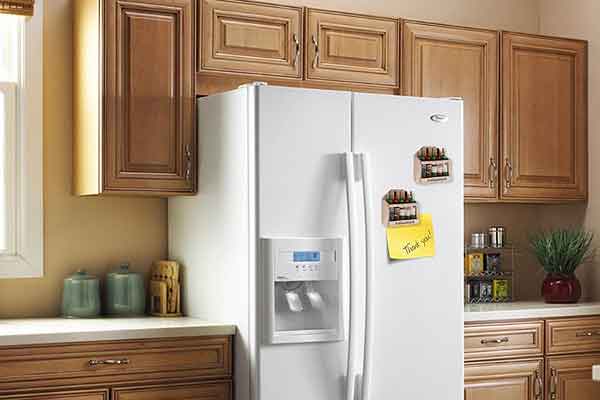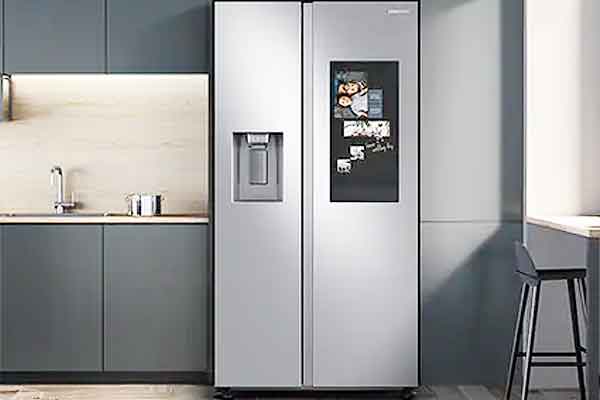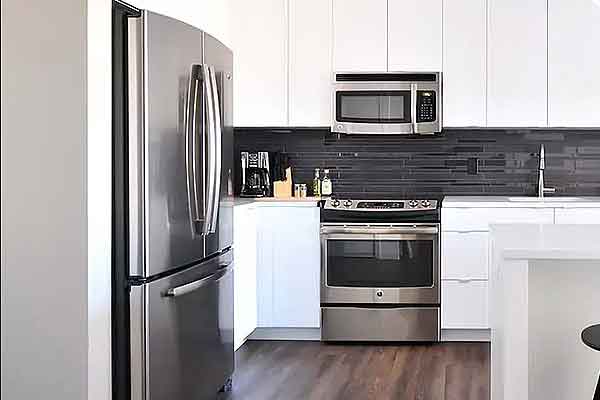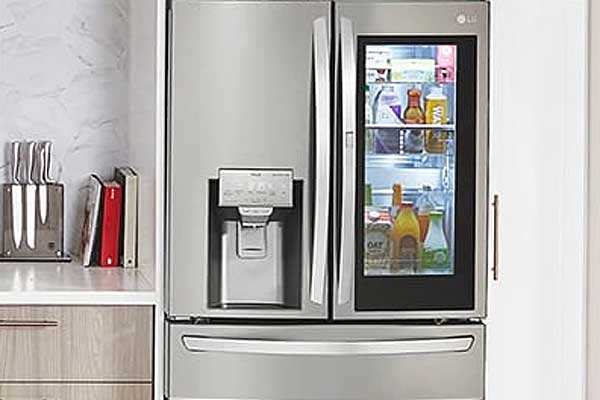Ever wondered Why Are LG Refrigerator Side Walls So Hot?
You’re not alone. Many LG fridge owners have encountered this puzzling phenomenon. It’s important to grasp why the side walls of your LG fridge generate heat, as it can help troubleshoot and prevent potential issues in the refrigerated space.
The heat on the side walls of your fridge is caused by various factors, including insulation and condensation. In this article, we’ll explore these mechanisms to put your mind at ease. By referring to your user manual (check page number), you can find valuable information about these heating occurrences.
So, what’s causing all that heat on the sides of your home? Let’s delve into the reasons behind those warm side walls and uncover how you can resolve any concerns or questions you may have about energy efficiency. But first, let’s take a quick look at what lies behind those sleek surfaces on the paint page.

The Science Behind Refrigerator Heat
LG refrigerators, like the Samsung fridge, employ a cooling system located at the back or rear top part of the appliance. This system works tirelessly to maintain an optimal internal temperature for your food and beverages. As a result, heat is generated during this cooling process, which is then dissipated through the sides and cabinet walls.
Now that we’ve scratched the surface, let’s dive deeper into each possible cause of excessive heat on your LG refrigerator’s sides in order to shed light on this common issue faced by many users. Is there a question about the Samsung refrigerator’s paint?
Stay tuned for more insights!
Reasons for Hot Side Walls in LG Refrigerators
1. Dirty Condenser Coils: A Cause of Excessive Heat
Dirty condenser coils can cause the side walls of your LG refrigerator, as well as the sides of your Samsung refrigerator, to become hot.
Cleanliness plays a crucial role in maintaining the performance of a Samsung refrigerator. One commonly overlooked aspect is the condition of the Samsung condenser coils. Over time, these Samsung coils can accumulate dust, dirt, and debris, hindering their ability to effectively dissipate heat. As a result, the Samsung refrigerator works harder to cool down its internal components, leading to increased heat on the side walls.
Cleaning the Samsung Condenser Coils
To address this issue with your Samsung appliance, it is essential to regularly clean the condenser coils on the wall-mounted unit. Here’s how you can do it.
- Unplug your refrigerator from the power source.
- Locate the condenser coil at the back or bottom wall of your LG refrigerator.
- Use a vacuum cleaner with a brush attachment or a soft brush to gently remove any visible dirt and debris from the coils on the wall.
- If necessary, use a coil cleaning brush or a coil cleaning solution specifically designed for refrigerators to clean the wall.
By keeping your condenser coils clean, you can ensure proper heat dissipation and prevent excessive heating on the side walls of your LG refrigerator.
2. Malfunctioning Condenser Fan: Addressing Overheating
The condenser fan in an LG refrigerator is crucial for airflow and cooling down components within the appliance. If this fan malfunctions or stops working, it can impact temperature regulation and cause overheating issues. The fan helps maintain the wall’s stability.
If you suspect that your condenser fan is not functioning correctly, here are some steps you can take to troubleshoot the issue.
- First, check if there is any debris or dirt buildup on the wall behind the fan. If so, clean it thoroughly.
- Next, inspect the wall for any signs of damage or cracks that may be affecting the fan’s performance.
- Finally, ensure that the wall is securely mounted and properly aligned with the fan.
By following these steps, you can determine if the wall is the cause of the malfunctioning condenser fan.
- Check if there are any obstructions blocking the movement of the fan blades.
- Ensure that there are no loose connections or damaged wires affecting its operation.
- If necessary, consult an authorized technician for further inspection and repair.
By addressing any issues with your condenser fan promptly, you can prevent excessive heat buildup on the side walls of your LG refrigerator.
3. Insufficient Airflow: Optimizing Cooling Efficiency
Insufficient airflow around the refrigerator can contribute to excessive heat on its side walls.
Proper airflow is crucial for maintaining optimal temperature levels inside your LG refrigerator. Insufficient clearance around the appliance can impede the flow of air and result in increased heat on the side walls.
To ensure adequate airflow, consider the following:
- Leave sufficient space between the back of the refrigerator and the wall or other objects.
- Avoid overcrowding the surrounding area with items that may obstruct ventilation.
- Clean any dust or debris accumulated near vents or grilles that facilitate air circulation.
By allowing unrestricted airflow around your LG refrigerator, you can minimize heat accumulation on its side walls and enhance overall cooling efficiency.
The Mechanics of LG Refrigerators
1. LG Refrigerator Design Overview
LG refrigerators are meticulously designed to provide efficient cooling and food preservation. These appliances incorporate various features and components that work together to maintain optimal temperature levels. Here is an overview of LG refrigerator models and their construction:
- Size and Layout: LG offers a range of refrigerator sizes and configurations, including side-by-side, French door, and top-freezer models. Each design aims to maximize storage capacity while ensuring easy access to stored items.
- Insulation: LG refrigerators feature high-quality insulation materials that help minimize heat transfer between the inside and outside of the appliance. This insulation plays a crucial role in maintaining consistent temperatures and reducing energy consumption.
- Doors and Seals: The refrigerator doors are equipped with sturdy hinges and seals to ensure a tight closure. This feature helps maintain the internal temperature by preventing warm air from entering and cold air from escaping.
- Shelves and Compartments: LG refrigerators are equipped with adjustable shelves and compartments to accommodate various food items. These shelves are typically made of durable tempered glass, which is easy to clean and can withstand heavy loads.
- Control Panels: Many LG refrigerator models come with advanced control panels located on the exterior. These panels allow users to adjust temperature settings, control humidity levels, and access additional features such as ice and water dispensers.
2. Heat Generation in LG Refrigerators
While refrigerators are primarily designed to cool and preserve food, they also generate heat as a byproduct of their operation. Understanding the sources of heat production is crucial in comprehending why LG refrigerator side walls can become hot. Some key sources of heat generation within LG refrigerators include:
- Compressor: The compressor is an integral part of the refrigeration system. It compresses the refrigerant gas, which increases its temperature. As the refrigerant passes through the compressor, it releases heat energy.
- Condenser Coils: LG refrigerators incorporate condenser coils that facilitate the transfer of heat from the refrigerant to the surrounding environment. These coils can become warm as they release heat, contributing to the overall heat generation.
- Motors and Fans: LG refrigerators utilize motors and fans to circulate air and maintain temperature consistency. The operation of these components generates heat, particularly in the motor coils.
3. Heat Transfer Mechanisms
Heat transfer plays a crucial role in how the generated heat moves within an LG refrigerator. Three primary mechanisms are involved in heat transfer: conduction, convection, and radiation.
- Conduction: Conduction is the transfer of heat through direct contact between materials. In the case of LG refrigerators, heat generated by components such as the compressor and condenser coils is conducted through solid materials, including metal, to the side walls. This conduction process allows the heat to spread throughout the refrigerator.
- Convection: Convection involves the transfer of heat through the movement of fluids or gasses. In LG refrigerators, convection plays a significant role in transferring heat from the internal components to the side walls. Air inside the refrigerator circulates due to natural convection or with the assistance of fans. This airflow helps carry away heat and contributes to the elevated temperature of the side walls.
- Radiation: Radiation refers to the transfer of heat through electromagnetic waves. In LG refrigerators, infrared radiation is responsible for transferring heat energy. Internal components, including the compressor and condenser coils, emit infrared radiation, which contributes to the heat absorbed by the side walls.
Understanding these heat transfer mechanisms provides insight into why LG refrigerator side walls can feel hot to the touch. The combination of conduction, convection, and radiation results in an overall increase in side wall temperature as part of the heat dissipation process within the refrigerator.

Factors Influencing Hot Side Walls in LG Refrigerators
1. Insufficient Ventilation
Insufficient ventilation can have a significant impact on the temperature of LG refrigerator side walls. When airflow and ventilation within the refrigerator are limited, heat dissipation becomes less efficient, leading to higher side wall temperatures. Some potential consequences of insufficient ventilation include:
- Heat Trapping: Without proper airflow, heat generated by internal components, such as the compressor and condenser coils, may get trapped inside the refrigerator. This trapped heat gradually raises the temperature of the side walls.
- Reduced Cooling Efficiency: Insufficient ventilation can hinder the refrigerator’s overall cooling efficiency. As heat builds up, the refrigerator’s compressor has to work harder to maintain the desired temperature, resulting in increased energy consumption.
To improve ventilation efficiency and alleviate the issue of hot side walls, the following solutions can be considered:
- Clear Air Vents: Ensure that the air vents inside the refrigerator are not blocked or obstructed by items. This allows for unrestricted airflow and better heat dissipation.
- Proper Clearance: Leave sufficient space between the refrigerator and surrounding walls or cabinets. This clearance allows air to circulate freely around the refrigerator, facilitating improved ventilation.
- Clean Condenser Coils: Regularly clean the condenser coils, located at the back or bottom of the refrigerator, to remove dust and debris. Dirty coils can impede heat dissipation and contribute to hotter side walls.
2. Inefficient Heat Exchangers
Inefficient heat exchangers, particularly the condenser coils, can also impact the temperature of LG refrigerator side walls. Heat exchangers are responsible for transferring heat from the refrigerant to the surrounding environment. If these components are inefficient or faulty, it can lead to increased side wall temperatures. Some considerations regarding inefficient heat exchangers include:
- Reduced Heat Dissipation: Inefficient condenser coils may struggle to release heat efficiently. This inefficiency can cause more heat to be retained within the refrigerator, leading to hotter side walls.
- Overworking Components: When heat exchangers are inefficient, other components, such as the compressor and fans, may have to compensate for the inadequate heat dissipation. This overworking of components can contribute to increased heat generation and further elevate side wall temperatures.
To address the issue of inefficient heat exchangers and mitigate the impact on side wall temperature, the following steps can be taken:
- Regular Maintenance: Schedule regular maintenance for the refrigerator, including professional inspection and cleaning of condenser coils. This helps ensure optimal performance and efficient heat dissipation.
- Timely Repairs: If you suspect any issues with the condenser coils or other heat exchangers, promptly address them by contacting an authorized service provider. Timely repairs can prevent further deterioration of heat transfer efficiency.
C. Overcrowded Refrigerator Interiors
The arrangement of items within an LG refrigerator can also influence the temperature of its side walls. Overcrowding the refrigerator interiors can impede proper airflow and obstruct heat dissipation. Examining the correlation between overcrowding and increased side wall temperature reveals the following:
- Restricted Airflow: When the refrigerator is overcrowded, air circulation becomes limited. This restricts the movement of cool air and impedes the dissipation of heat, causing side walls to become hotter.
- Heat Transfer Obstacles: Overcrowded shelves and compartments can obstruct the transfer of heat from internal components to the side walls. This can result in localized temperature increases and uneven heat distribution.
To ensure optimal temperature distribution and reduce side wall heat due to overcrowding, consider the following strategies:
- Organize Items: Arrange items in a way that allows for proper airflow and circulation. Avoid blocking air vents and maintain clear pathways for air movement within the refrigerator.
- Optimal Spacing: Leave adequate space between food items to promote better heat transfer. This allows cool air to flow freely and prevents the accumulation of heat around certain areas.
- Remove Unnecessary Items: Regularly assess the contents of the refrigerator and remove any items that are no longer needed. This helps maintain sufficient space for proper airflow and reduces the strain on the cooling system.
By addressing insufficient ventilation, inefficient heat exchangers, and overcrowding, it is possible to mitigate the factors that contribute to hot side walls in LG refrigerators. These strategies can help maintain optimal cooling efficiency and prolong the lifespan of the appliance.
LG Refrigerator Models and Side Wall Heat
1. Model-Specific Features
LG offers a range of refrigerator models, each with its own unique design and features. Understanding how different LG refrigerator models handle heat dissipation can provide insights into variations in side wall temperature. Key considerations include:
- Ventilation Systems: LG refrigerator models may incorporate different ventilation systems to enhance heat dissipation. Some models utilize strategically placed vents and fans to improve airflow, ensuring efficient cooling and minimizing side wall heat.
- Enhanced Insulation: Certain LG refrigerator models may feature advanced insulation materials that offer better thermal resistance. Improved insulation helps reduce heat transfer to the side walls, resulting in lower side wall temperatures.
- Heat Transfer Design: LG employs various design techniques to optimize heat transfer within different refrigerator models. This includes the placement of heat-generating components, such as the compressor and condenser coils, to minimize their impact on the side wall temperature.
Highlighting the variations in side wall temperature across different LG refrigerator models can help consumers make informed decisions based on their specific cooling needs and preferences.
2. Energy Efficiency and Side Wall Heat
Energy-efficient features in LG refrigerators can play a significant role in managing side wall heat. Examining the impact of energy-efficient features on side wall temperature involves considering the following factors:
- Advanced Insulation Materials: Energy-efficient LG refrigerator models often incorporate improved insulation materials. These materials help reduce heat transfer and minimize the amount of heat reaching the side walls, resulting in cooler side wall temperatures.
- Variable Speed Compressors: Some LG refrigerator models employ variable speed compressors that can adjust their cooling output based on the load and ambient conditions. This allows for better temperature regulation and can contribute to lower side wall temperatures.
- Smart Cooling Systems: LG’s smart cooling systems utilize sensors and algorithms to monitor and adjust internal temperatures. By maintaining more precise temperature control, these systems can optimize cooling efficiency and minimize side wall heat.
Assessing the effectiveness of energy-saving technologies in managing side wall heat is crucial for environmentally conscious consumers and those seeking appliances that operate efficiently without compromising cooling performance.
By evaluating model-specific features and energy-efficient technologies, consumers can select an LG refrigerator that aligns with their desired side wall temperature preferences while also considering energy-saving benefits.
Impact of Ambient Temperature on LG Refrigerator Side Walls
The ambient temperature surrounding an LG refrigerator can significantly influence the temperature of its side walls. Understanding how external temperature affects the side wall temperature involves investigating the relationship between ambient temperature and heat dissipation efficiency. Key considerations include:
1. Heat Exchange Process:
LG refrigerators rely on the process of heat exchange to dissipate heat from the internal components to the surrounding environment. As the ambient temperature increases, the temperature gradient between the refrigerator’s interior and the external environment decreases. This reduced gradient makes it more challenging for the refrigerator to release heat efficiently, resulting in higher side wall temperatures.
2. Cooling System Load:
Higher ambient temperatures increase the workload on the refrigerator’s cooling system. The compressor has to work harder to maintain the desired internal temperature, leading to increased heat generation. This additional heat output can contribute to elevated side wall temperatures.
3. Ventilation Efficiency:
The efficiency of heat dissipation is closely tied to the ventilation system and airflow surrounding the refrigerator. Higher ambient temperatures can impact the efficiency of airflow and ventilation, reducing the refrigerator’s ability to expel heat. As a result, the side walls may become hotter.
It’s important to note that while LG refrigerators are designed to perform optimally within specified ambient temperature ranges, extremely high ambient temperatures can challenge their cooling capabilities and lead to higher side wall temperatures.
To mitigate the impact of ambient temperature on side wall heat and improve heat dissipation efficiency, consider the following:
4. Adequate Clearance:
Ensure the refrigerator has sufficient space around it, especially in areas where ambient temperature may be high, such as near ovens or direct sunlight. This clearance allows for better airflow and ventilation, aiding in heat dissipation.
5. Ambient Temperature Control:
If possible, avoid placing the refrigerator in areas with excessively high ambient temperatures. Providing a relatively cooler environment for the refrigerator helps maintain its cooling efficiency and keeps side wall temperatures within an acceptable range.
6. Regular Maintenance:
Regularly clean the condenser coils and inspect the ventilation system to ensure optimal airflow. Dust and debris accumulation can hinder heat dissipation, making the refrigerator more susceptible to the impact of ambient temperature.
Understanding the relationship between ambient temperature and heat dissipation efficiency is crucial in managing side wall temperatures in LG refrigerators. By optimizing ventilation, controlling ambient temperature, and ensuring regular maintenance, it’s possible to mitigate the adverse effects of high ambient temperatures and maintain cooler side walls.

Dirty Condenser Coils and How to Clean Them
Accumulated dirt and debris on condenser coils restrict proper heat dissipation, leading to hot side walls. Regularly cleaning the condenser coils helps maintain optimal performance and prevents overheating. Here’s how you can clean them effectively:
First, make sure to unplug your LG refrigerator from the power source before starting any maintenance work.
- Locate the condenser coils: The condenser coils are usually located at the back of the refrigerator or underneath it. They are responsible for releasing heat generated by the refrigeration process.
- Prepare cleaning tools: Gather a vacuum cleaner with a brush attachment or a soft-bristled brush that can reach into tight spaces.
- Remove dust and debris: Gently vacuum or brush away any visible dust, dirt, or debris from the condenser coils. Be careful not to apply excessive pressure that could damage the delicate fins of the coils.
- Pay attention to hard-to-reach areas: Use a narrow crevice attachment on your vacuum cleaner or a coil cleaning brush to access hard-to-reach areas between the fins of the condenser coils.
- Clean off stubborn dirt: If there is stubborn dirt or grime stuck on the coils, dampen a cloth with warm water and mild detergent. Gently wipe away the dirt, taking care not to bend or damage the coils in the process.
- Check for paint damage: While cleaning, keep an eye out for any signs of peeling paint on the side walls near the condenser coils. If you notice any paint damage, it may indicate an issue with excessive heat buildup within your refrigerator’s system. In such cases, it is advisable to contact LG customer support for further assistance.
- Seal any gaps or leaks: Inspect for any gaps or leaks around where your refrigerator meets its surroundings (e.g., cabinets). These gaps can allow warm air to enter and hinder the cooling process. Use appropriate sealing materials to close any gaps and ensure a proper seal.
Remember, when cleaning the condenser coils, you should avoid direct contact with any metal parts or sharp objects that could cause damage. It is always recommended to refer to your refrigerator’s user manual for specific instructions on cleaning and maintenance.
Importance of Proper Airflow Around Your Refrigerator
Proper airflow around your LG refrigerator is crucial for efficient cooling and preventing the occurrence of hot side walls. When the side walls of your refrigerator feel unusually hot, it is a clear indication that there might be an issue with the airflow.
1. Maintaining Optimal Temperature:
One of the primary reasons why adequate airflow is necessary is to maintain the refrigerated space at an optimal temperature. Your refrigerator relies on a complex system involving components such as the evaporator, compressor, and insulation to cool its interior. However, if there isn’t enough ventilation space around it, these components may struggle to function effectively, leading to overheating.
2. Ensure Sufficient Space:
To prevent this from happening, it is crucial to ensure that there is sufficient space between the back of your refrigerator and any surrounding objects or walls. By maintaining a suitable gap, you allow air to circulate freely around your appliance, facilitating efficient cooling and preventing excessive heat buildup.
3. Importance of Ventilation Grilles:
Your refrigerator is designed with strategic ventilation grilles that promote air circulation. Blocking these openings can disrupt the natural flow of air and impede the cooling process.
4. Guidelines for Ventilation Grilles:
- Location: Familiarize yourself with the location of the ventilation grilles in your specific refrigerator model.
- Clearance: Ensure ample clearance around each grille to allow for unrestricted airflow.
- Cleaning: Regularly clean the grilles to prevent dust or debris accumulation that can obstruct airflow.
By adhering to these guidelines and promoting proper airflow, you maximize the efficiency of your refrigerator’s cooling system while minimizing potential issues caused by insufficient airflow.
Tips to Reduce Excessive Heat from Freezer Exterior
There are a few simple steps you can take to alleviate this issue. By following these tips, you can ensure that the outside of your freezer remains at a safe and comfortable temperature.
1. Keep Freezer Door Seals Clean and Intact
One of the common reasons for excessive heat on the side walls of your refrigerator is damaged door seals. When these seals are compromised, warm air from outside can seep into the freezer, causing it to work harder and generate more heat.
To prevent this, make sure to keep the door seals clean and free from any debris or residue. Regularly wipe them down with a mild detergent solution and inspect them for any signs of wear or damage. If you notice any issues with the seals, it’s important to replace them promptly to maintain optimal cooling efficiency.
2. Avoid Overloading the Freezer
Another factor that can contribute to increased heat on the outside of your freezer is overloading it with too many items. When the freezer is packed tightly, it restricts airflow within the unit, making it difficult for cold air to circulate properly.
As a result, heat can build up on the side walls as the compressor works harder to maintain a consistent temperature. To prevent this, be mindful of how much food you store in your freezer and avoid overcrowding it. Allow sufficient space between items for proper airflow and circulation.
3. Regularly Defrost Your Freezer
Ice accumulation inside your freezer not only affects its cooling capabilities but also leads to excessive heat on its exterior walls. When ice builds up on evaporator coils or other components, it acts as an insulator, preventing efficient cooling and causing more heat generation.
To combat this issue, make sure to defrost your freezer regularly according to manufacturer guidelines or when ice buildup becomes noticeable. This will help remove any excess ice and ensure that your freezer operates optimally, reducing the heat emitted from its outside walls.
By implementing these tips, you can effectively reduce excessive heat on the side walls of your LG refrigerator. Keeping the door seals clean and intact, avoiding overloading the freezer, and regularly defrosting it will help maintain proper cooling efficiency and prevent unnecessary heat buildup. Remember to perform these maintenance tasks periodically to ensure that your freezer remains in top-notch condition while keeping its exterior cool to the touch.

Troubleshooting Tips for Hot Side Walls in LG Refrigerators
If you’ve noticed that the side walls of your LG refrigerator are unusually hot, it’s important to address this issue promptly. Hot side walls can be a sign of an underlying problem that requires attention.
1. Check if the condenser coils are dirty or blocked
One common cause of hot side walls in LG refrigerators is dirty or blocked condenser coils. Over time, these coils can accumulate dust, dirt, and debris, hindering their ability to dissipate heat effectively. To check if this is the case, follow these steps:
- Unplug the refrigerator from the power source.
- Locate the condenser coils at the back or bottom of the refrigerator.
- Inspect the coils for any visible signs of dirt or blockage.
- If dirty, use a vacuum cleaner with a brush attachment or a soft brush to gently clean off the debris.
Regularly cleaning your condenser coils can prevent overheating and ensure optimal performance of your refrigerator.
2. Ensure that the condenser fan is functioning properly
The condenser fan plays a crucial role in cooling down both the compressor and condenser coils. If it malfunctions or stops working altogether, it can lead to excessive heat buildup and result in hot side walls. Here’s what you can do:
- Listen for any unusual noises coming from behind your refrigerator while it’s running.
- If you don’t hear the sound of a running fan, there may be an issue with its operation.
- Contact a professional technician to inspect and repair the fan if necessary.
A properly functioning condenser fan is essential for maintaining adequate airflow and preventing overheating.
3. Verify that there is adequate space around the refrigerator
Proper airflow and ventilation are crucial for keeping your LG refrigerator cool and preventing hot side walls. Make sure there is sufficient space around the refrigerator to allow for adequate air circulation. Consider the following:
- Leave a gap of at least 2-3 inches between the back of the refrigerator and the wall.
- Avoid placing items directly against the sides of the refrigerator.
- Ensure that there are no obstructions blocking the vents or air intake areas.
By providing enough space for airflow, you can help dissipate heat efficiently and reduce the likelihood of hot side walls.
Conclusion
To keep your LG refrigerator cool and efficient, it is important to address the issue of hot side walls. The reasons for this problem can vary, but two common culprits are dirty condenser coils and malfunctioning condenser fans.
By understanding why side walls of LG refrigerators become hot and implementing necessary measures like cleaning condenser coils regularly, ensuring proper airflow, and troubleshooting potential issues, you can keep your refrigerator running efficiently while extending its lifespan.
Remember to consult your user manual for specific instructions related to your model of LG refrigerator or seek assistance from an authorized service provider if needed.
FAQs
Can hot side walls in my LG refrigerator affect its performance?
Yes, hot side walls can indicate underlying issues that may impact the refrigerator’s cooling efficiency. It is important to address this problem promptly to avoid further complications.
How often should I clean the condenser coils of my LG refrigerator?
Cleaning the condenser coils once every six months is generally recommended. However, if you have pets or live in a dusty environment, more frequent cleaning may be necessary.
Is it normal for the side walls of my LG refrigerator to feel warm?
It is normal for some warmth to radiate from the side walls due to heat dissipation during operation. However, excessive heat or hot spots could indicate a problem that requires attention.
What can I do if the condenser fan in my LG refrigerator malfunctions?
If you suspect a malfunctioning condenser fan, it is best to contact an authorized LG technician for diagnosis and repair. Attempting to fix it yourself may void your warranty or cause further damage.
How can I ensure proper airflow around my LG refrigerator?
To promote proper airflow, leave sufficient space between the refrigerator and surrounding objects. Avoid blocking ventilation areas and ensure there are no obstructions hindering air circulation.
Are there any energy-saving benefits associated with keeping the side walls of my LG refrigerator cool?
Yes, maintaining optimal operating temperatures helps your refrigerator run efficiently, reducing energy consumption and potentially lowering your electricity bills.
Should I be concerned if only one side wall of my LG refrigerator feels hot?
Uneven temperature distribution could be indicative of an issue with airflow or component functionality. Consider checking for any obstructions or contacting an authorized technician for assistance.
Remember that not all models of LG refrigerators are exactly alike, so specific instructions may vary. Always refer to your user manual or seek professional advice when in doubt.

